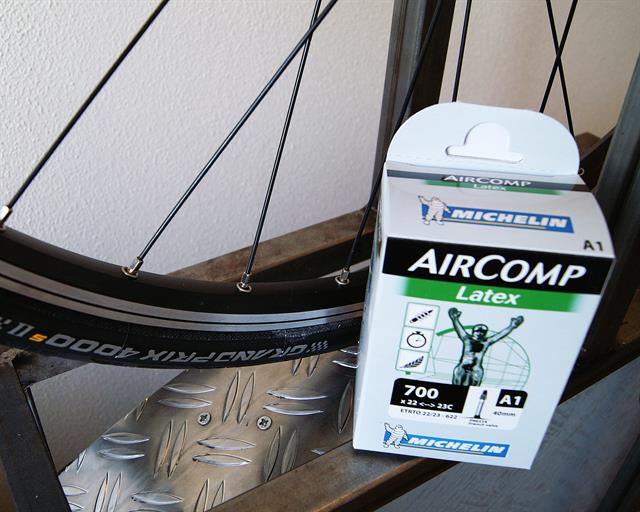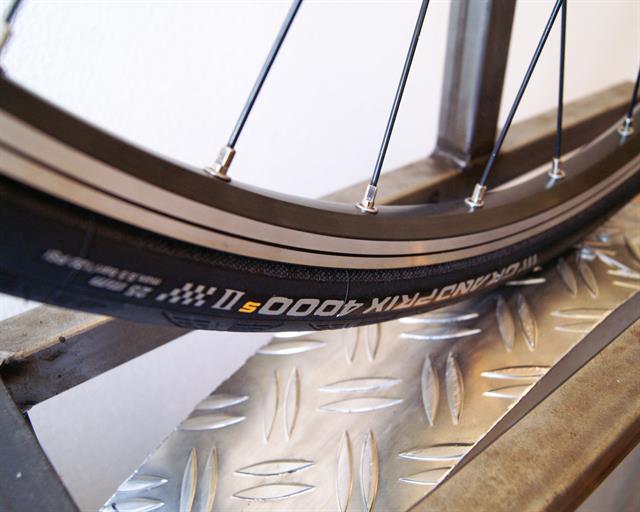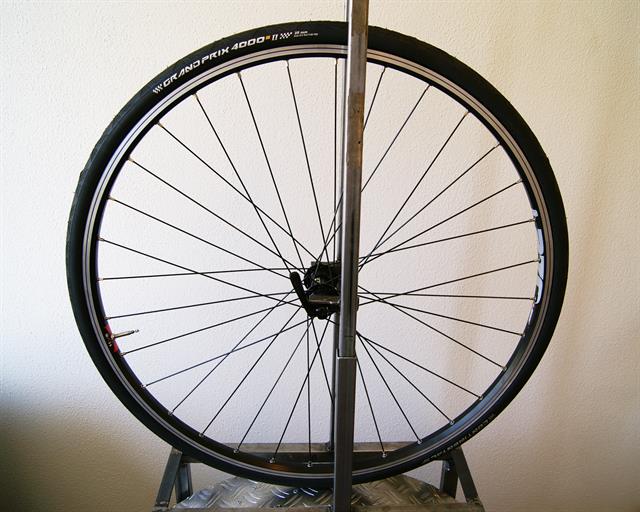Road Bike Tire Test: Continental Grand Prix 4000S II Latex Tube 25
Contents and Test Summary
- Introduction
- Manufacturer Specifications
- Size, Weight, Thickness
- Rolling Resistance: 11.8 Watts
- Puncture Resistance: 52 Points
- Static Wet Grip: No Data
- Conclusion: 5.0 / 5 Highly Recommended
- Comments
- Continental Grand Prix 4000S II Latex Tube 25
(100% is best)

This is a retest of the Continental Grand Prix 4000S II reviewed Here except this time I've substituted the standard 100 grams Continental butyl inner tube for a 80 grams Michelin AirComp A1 Latex tube. I've chosen the GP4000S II to test a latex inner tube simply because it's the fastest road bike tire I had the chance to test up to now. I've also tested the Vittoria Open Corsa CX III with a latex tube, results are Here. Why a Michelin latex tube instead of some other brand? Because it's the cheapest and best available latex tube.
If you're purely interested in the differences between butyl and latex tubes, I recommend you to also read this special article which includes latex,butyl and light butyl tubes.
Everybody wants "free" speed, latex tubes are faster for sure but have some disadvantages when compared to butyl inner tubes as well. The biggest problem is that latex tubes lose pressure quite quickly. When setting air pressure to 100 psi in the morning, you'll probably only have 90 psi left over in the evening and 80 psi the next day. This means you will have to check air pressure and inflate your tires every day. If you just want to set and forget, stick to standard butyl tubes. The second problem is that you have to be really careful when mounting your tires and make sure your rim does not have any sharp edges as these will rip the latex tube apart.
Inner Tubes Specifications
Butyl Inner Tube
- Brand: Continental
- Model: Race 28, 18-25 x 622
- Weight: 100 grams
Latex Inner Tube
- Brand: Michelin
- Model: AirComp A1 Latex
- Weight: 80 grams
Manufacturer Specifications
| Manufacturer Specifications | |
|---|---|
| Brand | Continental |
| Model | Grand Prix 4000S II Latex Tube |
| Year | 2014 |
| Tire Type | Tubetype (clincher) |
| Supplied By | Bought in store |
| New or Used | New |
| Mileage | 0 km |
| Price Range | High |
| Buy At | |
| Manufacturer part number | 0100945 |
| TPI | 3/330 |
| Compound | Black Chili |
| Bead | Folding |
| ETRTO | 25-622 |
| Size Inch | 28" |
| Specified Width (mm) | 25 |
| Specified Weight | 225 grams |
| Max Air Pressure (psi) | 120 |
| Made In | Pro Data |
| Available Sizes |
20-622 (700x20C) 23-622 (700x23C) 25-622 (700x25C) 28-622 (700x28C) 23-571 (650x23C) |
Continental Grand Prix 4000S II Latex Tube 25 Test Results

Size, Weight, and Thickness Measurements
| Size, Weight and Thickness Measurements | |
|---|---|
| Specified Weight | 225 grams |
| Measured Weight | 215 grams |
| System Adjusted Weight (tire + inner tube (100 gr) |
315 grams |
| Measured Width | 27 mm (un-round) |
| Measured Height | 25 mm (un-round) |
| Total Tire Thickness Center | 2.9 mm |
| Total Tire Thickness Sidewall | Pro Data |
| Unmounted Casing Width | No Data |
| Unmounted Tread Width | No Data |
| Tread Cover (Tread / Casing Ratio) | No Data |
| All size measurements are taken at an air pressure of 100 psi / 6.9 bars on a 17.8 mm inner width rim. | |
No differences, same as with butyl inner tube.
Rolling Resistance Test Results
| Rolling Resistance Test Results | |
|---|---|
| Inner Tube | Michelin Latex |
| Measured Width | 27 mm (un-round) |
| Rolling Resistance Real tire width in mm: 22-24 = 132 psi/9.1 bar 25-27 = 120 psi/8.3 bar 28-29 = 108 psi/7.4 barUltra High Air Pressure (120 psi / 8.3 bar) |
Pro Data |
| Rolling Resistance Real tire width in mm: 22-24 = 110 psi/7.6bar 25-27 = 100 psi/6.9 bar 28-29 = 90 psi/6.2 barExtra High Air Pressure (100 psi / 6.9 bar) |
Pro Data |
| Rolling Resistance Real tire width in mm: 22-24 = 88 psi/6.1 bar 25-27 = 80 psi/5.5 bar 28-29 = 72 psi/5.0 barHigh Air Pressure (80 psi / 5.5 bar) |
11.8 Watts CRR: 0.00354 |
| Rolling Resistance Real tire width in mm: 22-24 = 66 psi/4.6 bar 25-27 = 60 psi/4.1 bar 28-29 = 54 psi/3.7 barMedium Air Pressure (60 psi / 4.1 bar) |
Pro Data |
| The Road Bike section is a multi tire size section, air pressures have been adjusted to the measured casing width. All numbers are for a single tire at a speed of 29 km/h / 18 mph and a load of 42.5 kg / 94 lbs. Use the formula: RR (Watts) = CRR * speed (m/s) * load (N) to calculate rolling resistance at a given speed and load. |
|
The latex tube definitely has less rolling resistance when compared to the butyl tube, although the difference isn't as big as seen with mountain bike tires Read my special MTB article. Tests are run at 18 mph / 29 km/h, which might be a little low for road bikes.
At lower air pressures, the differences start getting bigger but nothing extreme. A breakdown of the differences at different air pressures:
- At 120 psi / 8.3 bar, the latex inner tube has 1.6 watts less rolling resistance.
- At 120 psi / 8.3 bar, Coefficient of rolling resistance (CRR) is 0.00048 lower
- At 100 psi / 6.9 bar, the latex inner tube has 1.8 watts less rolling resistance.
- At 100 psi / 6.9 bar, Coefficient of rolling resistance (CRR) is 0.00054 lower
- At 80 psi / 5.5 bar, the latex inner tube has 1.9 watts less rolling resistance.
- At 80 psi / 5.5 bar, Coefficient of rolling resistance (CRR) is 0.00057 lower
- At 60 psi / 4.1 bar, the latex inner tube has 2.2 watts less rolling resistance.
- At 60 psi / 4.1 bar, Coefficient of rolling resistance (CRR) is 0.00066 lower
Puncture Resistance Test Results

| Puncture Resistance Test Results (higher is better) | |
|---|---|
| Total Puncture Score Tread | 52 Points |
| Total Puncture Score Sidewall | Pro Data |
| Tread Puncture Force Sharp Needle | 11 Points |
| Tread Puncture Force Blunt Needle | No Data |
| Tread Total Tire Thickness | 2.9 mm |
| Sidewall Puncture Force Sharp Needle | Pro Data |
| Sidewall Puncture Force Blunt Needle | No Data |
| Sidewall Total Tire Thickness | Pro Data |
No differences, same as with butyl inner tube.
Static Grip Test Results
NOTE: Grip test data is only available on tires tested after November 2018. You can find more information about our grip test here: Introducing Grip Testing
| Static Grip Test Results | |
|---|---|
| Wet Grip Average | No Data |
| Wet Grip Center | No Data |
| Wet Grip Edge | No Data |
| Grip in points = coefficient of friction * 100 Road bike grip test rim width = 19.0 mm |
|
Conclusion
- Continental Grand Prix 4000S II Latex Tube 25
(100% is best)
If you want pure speed, latex inner tubes are definitely worth the trouble. When making a correction for an average road bike speed of 23 mph / 36 km/h and a tire pressure of 120 psi, a pair of latex inner tubes have 4 watts less rolling resistance. If you like to run lower pressures, you will save close to 5 watts at 80 psi.
If you ride your bike every day, the 4 to 5 watts lower rolling resistance might not be worth the trouble of having to check air pressure and re-inflate your tires every day. If you forget to check air pressure before a ride, rolling resistance might actually be higher because of the lower air pressure.
- For maximizing performance : Latex inner tubes
- Set and forget: Butyl inner tubes
Update after testing the Vittoria Open Corsa CX III with a latex tube:
The differences between the Continental Grand Prix 4000S II and Vittoria Open Corsa CX III with latex tubes vs butyl tubes are small. The difference of at most 0.4 watts in a 4 part measurement is too small to draw a conclusion. I think you can use these 2 comparisons as a reference of how much you will gain with a latex tube, even if you have tires with very high rolling resistance or very low rolling resistance, the difference should be about 4-5 watts for a pair of tires when going for latex tubes.
RATING:
5.0
/ 5
TEST VERDICT:
Highly Recommended
